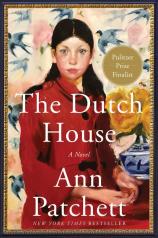The Dutch House
Review
The Dutch House
Ann Patchett’s new novel, THE DUTCH HOUSE, is a family story that reads like a modern fairy tale.
Danny Conroy and his older sister, Maeve, acutely feel the absence of their mother, who they have been told left the family years before to go to India to work with the poor. Their remote father, Cyril, throws himself into his work, buying and selling various real estate investments near where they live in the Philadelphia-area suburb of Elkins Park, Pennsylvania. His pride and joy are not his two children, but the ornate house in which they live. Itis nicknamed the Dutch House, not for its architectural style, but for the previous owners, the VanHoebecks, who still look down upon this fractured family from their old-timey portraits that still adorn the walls of their former home. The Dutch House was purchased as a gift for his new wife, Elna, who never liked it or felt at ease there, as evidenced by her frequent trips away, which soon became a permanent exile.
"Tinged with fairy-tale touches, such as orphaned children, an old house and an evil stepmother, THE DUTCH HOUSE makes us care deeply for Danny and Maeve, and root for them to regain what’s rightfully theirs."
Young Danny is devoted to Maeve, who has become a surrogate mother to him (and herself) in the wake of their mother’s disappearance when she was 10 and he was three. Despite her diabetes, Maeve is strong and caring, and Danny doesn’t feel the ache for his mother as much as his sister: “How could I miss someone I’d never known?” The pair solidify their bond over the years, which comes as a great support as their father retreats farther from the family: “Maeve and I were forever under the impression that we were moments away from cracking the code on our life, and that soon we would understand the impenetrable mystery that was our father….”
When Danny is 10, his father begins bringing a lady friend around, which is unusual in and of itself, as very few people ever darken the doorway of the Dutch House. From the start, it seems that Andrea is more captivated by the features of the house than its inhabitants (evil stepmother, anyone?). Despite having two young daughters herself, Andrea is far from the maternal type. After a quick courtship, she marries Cyril and moves into the Dutch House with her girls, Norma and Bright. Right away, everyone in the house feels the change, not just Danny and Maeve (who loses her room to Norma and is relocated to the third floor, Little Princess-style), but also Jocelyn and Sandy, the older women who are sisters and have worked for the family as housekeeper and cook for years. It’s clear that Andrea has her own ideas about how the house will be run from here on out.
Four years into their marriage, Cyril, now in his early 50s, has a heart attack on a job site and dies. His grief-stricken children return to the Dutch House to tell their stepmother the horrible news. Despite her fragility in the wake of her only known parent’s death, Maeve offers to quit her job and run the Conroy family business, to keep everything going smoothly. Danny agrees to do his part, which consists of going around and collecting the rent from his father’s various tenants. Andrea, who has no involvement with the business, rejects their plan and tells them that they are to move out, that she has claim to the house, the business and their father’s entire estate, and has no interest in sharing it with either of them.
A stunned Danny, who is now 15, packs one small suitcase and relocates to Maeve’s small apartment nearby, since she had been living on her own after college. The siblings cling together closer than ever. While Danny’s shock renders him silent, this exile makes Maeve furious: “My sister reared back with such ferocity that for a split second I thought she meant to hit me. ‘She stole from us. Do you not understand that? They’re sleeping in our beds and eating off our plates and we will never, never get any of it back.’” Will they ever regain their rightful place within their late father’s world? Is everything lost to them now --- money, livelihood, even the Dutch House?
Patchett’s latest work touches on many relatable and timely topics --- the bonds of family and how they are tested; family money and what happens when it’s gone. She offers up one family as a prism to explore these issues, but also looks at the idea of inherited wealth in this country. Tinged with fairy-tale touches, such as orphaned children, an old house and an evil stepmother, THE DUTCH HOUSE makes us care deeply for Danny and Maeve, and root for them to regain what’s rightfully theirs. If home is the place where, when you go there, they have to take you in, this novel is a home that lures you in, and you never want to leave.
Reviewed by Bronwyn Miller on September 26, 2019
The Dutch House
- Publication Date: January 5, 2021
- Genres: Fiction
- Paperback: 352 pages
- Publisher: Harper Perennial
- ISBN-10: 0062963686
- ISBN-13: 9780062963680




